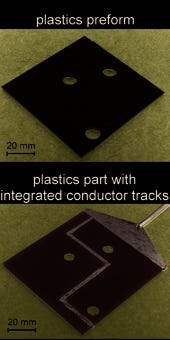Injection molding and more: Top-notch tech on display at IKV
The experts at the Institute of Plastics Processing (IKV) in Aachen, Germany, late last week provided a small group of journalists a close look at some of the cutting-edge technology they will discuss and display at the upcoming March colloquium. This article will highlight two truly forward-looking projects underway there, focused on injection molding.
October 26, 2009
The experts at the Institute of Plastics Processing (IKV) in Aachen, Germany, late last week provided a small group of journalists a close look at some of the cutting-edge technology they will discuss and display at the upcoming March colloquium. This article will highlight two truly forward-looking projects underway there, focused on injection molding. This week, other articles on the Institute’s work on extrusion, blowmolding, and composites processing will appear in your NewsFeed newsletter.
It is hard to say which of the two highlighted molding processes is more exciting. Important is to note that the Institute will hold its 25th annual International Plastics Technology Colloquium on March 3-4, 2010, with all of the presentations made and the machine demonstrations explained in both English and German. That conference will be an opportune time to see the processes in operation, and to pepper the experts at the Institute with questions.
|
Let’s start with a processing technology that does not yet have a name. The aim, as explained by Professor Walter Michaeli, the director of the IKV, is to combine a process similar to metal injection molding with thermoplastic molding, in a single mold, on a single machine. The potential advantages to standard insert, overmolded metal parts is that there is no need for metal-forming steps in advance of molding; the design of the metal portion can be much more complex; and there is no need for extra automation or personnel (depending on how the insertion is accomplished).
As MPW watched, Andreas Neuss, the engineer running the project, molded small PC/ABS panels that included a curved metal center. The metal is a zinc/tin alloy similar to that processed on laser sintering systems for rapid prototyping, or used for soldering; it is highly electrically conductive. Injection of the metal melt is accomplished with a small aggregating unit piggybacked on the injection mold. The aggregate serves both as dosing unit and metal injection system.
The bond between the disparate materials can be broken but you would need to be both strong and angry to do so; the metal does not separate from the plastic without serious effort. Neuss said his project group is working hard to test and improve upon the bond, likely either via some form of coating, or by injection of two types of metal.
The IKV reckons there might be enormous potential for the combo injection-molding/metal die-casting process for a large number of future applications, such as in the automotive and electronics industries.
Physical foaming revisited
Across the hall from Neuss and his machine, two of his colleagues were using an injection molding machine from Arburg to demonstrate the Institute’s ProFoam process. ProFoam, explained Michaeli, is a new means of physically foaming injection molded parts. The goal is to provide an easy-to-use and inexpensive process and system technology for foam injection molding.
There are other physical foaming processes available for injection molding; Trexel’s MuCell process is the best know, though the IKV also developed an earlier process, OptiForm, which is in commercial use. The new ProFoam set-up can use carbon dioxide or nitrogen, with the gas brought into the process at the feeder so that the blowing agent can diffuse into the polymer during the plasticization process. Unlike the MuCell process, the gases need not be supercritical.
On the IKV’s project, the plasticizing unit of the molding machine is sealed off in the rear section on the screw, and a sluice in a pressurized chamber is installed between the material hopper and the plasticizing unit. This sluice makes it possible to transport the granules into the pressurized screw cylinder under ambient conditions. Simple process control is achieved by having the pressure of the blowing fluid as the sole additional parameter that needs to be set.
Asked to note the advantages over current physical foaming processes, Michaeli said the ProFoam process, which is in advanced development stages, will require much lower investment. With ProFoam, no elaborate valve technology is required and the pressure of the blowing agent is just 50 bar maximum. So far part weights could be reduced bout 30% via the foaming.
Last Friday, as MPW watched the system in operation, the IKV was physically foaming PC/ABS onto an aluminum sheet, demonstrating one of the Institute’s other processes, for back injection molding onto real metal. For this, the mold needs to be heated to about 100ºC to activate the binder on the back of the metal sheet. This binder creates the bond between metal and plastic.
Asked about potential patent infringement issues with MuCell, the IKV engineers say that because their process stays away from supercritical gases, that aspect is not a problem. Trexel also has patents on physical foaming of very thin-walled parts; here the IKV reckons that its process, as long as it is used to mold parts 1.4 mm or thicker, will not infringe on those. —Matt Defosse
About the Author(s)
You May Also Like



